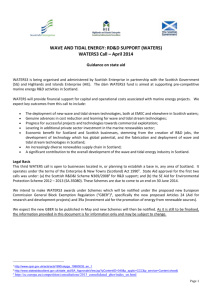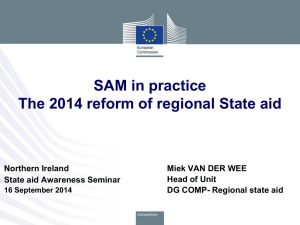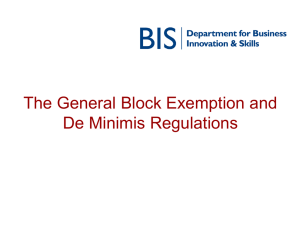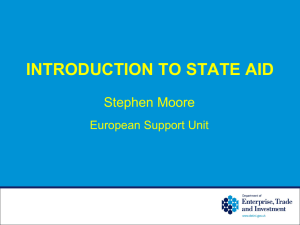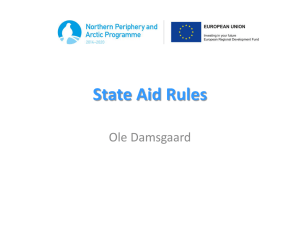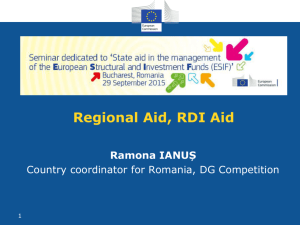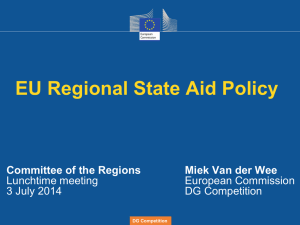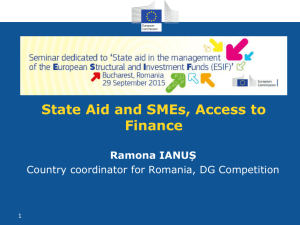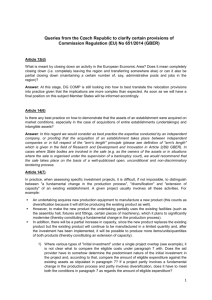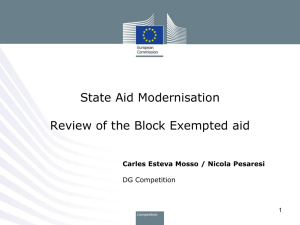Open
advertisement
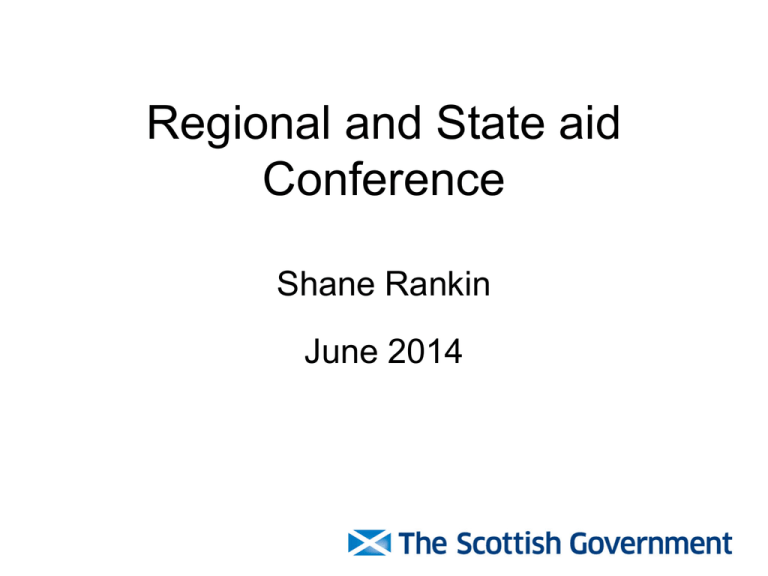
Regional and State aid Conference Shane Rankin June 2014 What does State aid affect? What’s in? – Organisations – Economic advantage – Liberalised markets What’s not? – Individuals – Market terms – State functions What’s new? • • • • New approach New opportunities New procedures New funding models State Aid Modernisation R&D Low carbon Human capital Growth Publication Tougher Investigations Evaluations More exemptions Faster Higher thresholds Fit with our priorities Wealthier and Fairer Key sectors Healthier Increasing housebuilding Employability Renewables sector Sustainable transport Reducing inequalities Home insulation scheme Safer and Stronger Strengthening communities funding Regeneration Capital Grant Fund Town Centre Housing Fund Smarter Greener Supporting employers Rural development National training programmes Climate change Zero waste Energy efficiency What now? • • • • Attend workshops Speak to State Aid Unit Read relevant rules Consider alternatives Regional aid and State aid Conference Ana Richardson June 2014 Outline • • • • What’s changed? Why do I need to know this? Can I continue current activities? Can I do new things? What’s changed? Adopted: In draft: • • • • • • • • • • • • • • Regional Aid de minimis R&D&I Environmental and Energy Risk Finance Broadband Aviation General Block Exemption Complaint-handling Transparency Notion of aid Rescue and restructuring aid Agriculture and forestry Fisheries Why? R&D&I Aid objective Fundamental research: Large Medium Small 100% 100% 100% 50-65% 60-70% 60-75% 70-80% 70-80% 80-90% 25-40% 60-70% 35-50% 70-80% 45-60% 80-90% 50% 60% 50% 60% 50% 60% Industrial research: Exempt Notifiable Experimental development: Exempt Notifiable Research infrastructure: Exempt Notifiable Environment and Energy • • • • • Market based mechanisms Promoting competitiveness Supporting cross-border infrastructure Security of electricity generation Exempted categories Broadband • Digital agenda • Technological neutrality • Ultra-fast broadband networks • Step change to connectivity • Reinforcement of open access Exempted aid Aid amount Higher thresholds Exempted aid Type of aid New categories What’s new? New categories Higher aid intensities 65% 55% 2007 - 2013 Higher thresholds Fundamental research: Industrial research: €20m → €40m €10m → €20m 2014 - 2020 What’s next? • Ask us about your existing activities • Ask us about planned activities • Don’t be shy – we’re here to help you Regional Aid: Potted summary • Regional aid = state aid permissible due to the circumstances in certain regions • Aid aimed at cohesion between regions, so targets regions which are relatively poorer than the EU average • 2 stage process: rules for the EU; then mapping for the member state • Aid is self-funded by member states • Regional Aid in Scotland distributed via SE, HIE and SDI; LAs to SMEs; and occasionally BPRA grants for business premises Basic designation • Step 1: GDP per capita <75% of EU average (3a status) (Commission decision) • Step 2: not ‘a status’, but difficult conditions (former ‘a’, low density population) (Commission decision) • Step 3: disadvantaged areas in developed member states (3c status) (Member State choice) – Based on lower GDP per capita and higher unemployment – Population allocation to member states, who then determine final coverage Assisted Areas – 80 Years of Tradition? - 20 New map for Scotland • Need AND opportunity – meets EU criteria, but area has to have a realistic prospect of using this particular form of aid for economic development and job creation • Reassess every area of Scotland – but accept that those designated previously are some of the most deprived and have on-going need for support 2014 map • Full H&I coverage – mix of sparsely populated and ‘c’ coverage • New areas in Angus, Borders, D&G, East and Midlothian • Reframed areas around best opportunities in West, Ayrshires, Fife, Stirling and Falkirk • Targeting SME investment sites more than large companies Main changes for 2014 • Stronger link to GBER – aid possible both under GBER and RAG • Aid to large enterprises restricted to new investments and new products/processes • Lower intervention rates than 2007 – down by 5% • More detailed checks for incentive effects GBER scope • Regional or SME aid up to EUR 7.5m • But not where a company has closed down same activity elsewhere in EEA in last 2 year, or plans to do so within next 2 years – no ‘aid-hopping’ • Usual restrictions apply! – Schemes with annual expenditure > EUR 150m – Aid to export related activities (which includes to another Member State) – Aid contingent on use of domestic over imported goods – Aid to facilitate the closure of uncompetitive coal mines – Regional aid in steel, coal, shipbuilding, synthetic fibres, transport and energy sectors, fisheries and agriculture – Schemes targeted at limited number of specific sectors – Undertakings in difficulty – Undertakings subject to an outstanding recovery order – Aid measures which violate Union law RAG scope • Steel and synthetic fibres sectors can’t get regional aid • Fishery and aquaculture and transport sector subject to specific rules, not the RAG. • RAG does not apply to aid to airports or the energy sector (energy generation, distribution and infrastructure) • Does not apply to firms in difficulty • Can apply where outstanding recovery order - but will be a factor in Commission’s decision • General rule – notify regional aid under the RAG – unless you can give the aid under the New GBER • Common assessment principles – Commission uses these to decide if aid will lead to increased R&D without adversely affecting trading conditions contrary to common interest Eligible costs (a)investment in tangible and intangible assets; (b)(b) estimated wage costs over 2 years OR (c)combination of (a) and (b) subject to cap of total (a) or (b) • Wage costs – net increase in employees compared with average over previous 12 months, jobs lost to be deducted from those created • Posts filled within 3 years of completion of works • Any investment by same beneficiary (group level) in same NUTS 3 area within 3 years of start of works part of single investment project • Aid beneficiary to contribute at least 25% of eligible costs GBER: Investment aid to SMEs (new Article 17) • Investment in tangible or intangible assets or estimated wage costs for 2 years • Setting up a new establishment, extension of existing establishment, diversification of output into new products or a fundamental change to production process of existing establishment • Acquisition of assets belonging to an establishment where it would otherwise have closed under market conditions • 20% for small companies – 10% for medium Different rules SME Large enterprise • • • • • initial investment in favour of “new economic activity” in the area concerned • Maintain jobs for 5 years • Assets must be new • Lease must continue for 5 years • costs of intangible assets only up to 50% of total investment costs any form of initial investment Maintain jobs for 3 years Assets do not need to be new Lease must continue for 3 years • GBER options – article 14 regional aid in assisted areas; or article 17 investment aid For example… SME • SME sets up, invests, creates jobs and maintains them for three years and generally behaves… • Eligible anywhere in Scotland under GBER up to EUR 7.5 m • 10% for SME’s in non-assisted areas • Option to use Article 17 SME investment aid – 20% for SME’s, 10% for medium • Higher intervention rates in assisted areas – 30/20/10% (small, medium, large) in ‘c’ areas – 35/25/15% in sparsely populated areas …and also… Large enterprise Large Enterprise • Launches new product category in existing location – eligible under GBER as ‘new economic activity’ up to EUR 7.5 m • Sets up in new NUTS 3 area without closing anything similar down in EEA – eligible under GBER up to EUR 7.5 m • Establishes new and innovative process – not clear • Applies for aid exceeding €7.5m – notified under RAG • Even if it’s for new product or process? Yes, notify under RAG Q&A
